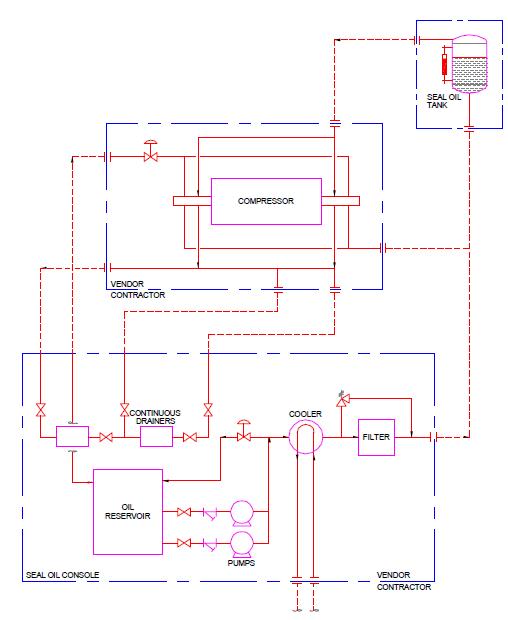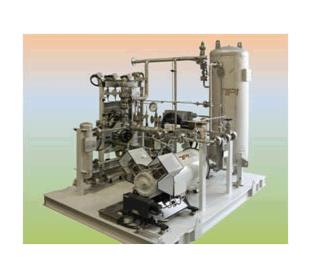1. Lube Oil Console
2. Run Down Tank
3. Seal Oil Console
4. Cooling Water Console
5. Suction Knockout Drum
6. Pulsation Dampener/Volume Bottles
7. Seal Gas Unit
Centrifugal and reciprocating compressors and their drives require a variety of auxiliary equipment to support their operation. The equipment for these compressors is described as below:-
1. Lube Oil Console
Compressor bearings receive lubricating oil from lube oil console. These lube oil console units are either stand alone or are directly mounted on compressor skid and supplied by compressor vendor. The console consists of lube oil reservoir, oil filters, oil coolers & lube oil pumps. Figure below shows typical lube oil console skid and lube oil cooler.
Lube oil and seal oil consoles should be located as close to compressor as possible. Oil return lines from the compressor and driver should have slope as suggested by vendor to compressor the inlet connection of seal traps, degassing tanks and oil reservoir. Vent lines for reservoir, compressor bearing and seal oil vents should be routed to a safe location.

Fig 1: Lube Oil Console Skid

Fig 2: Lube Oil Cooler

2. Run Down Tank
In many compressor installations, run down tanks are installed which provide lube oil supply during compressor shutdown and/or during power cut off to main lube oil pumps. Run down tanks are located at an elevated level as compared to compressor and flow of lube oil from run down tank to compressor is by gravity.
3. Seal Oil Console
The hydraulic seals, located at the outer ends of the compressor shaft, receive oil from the seal oil console. The seal oil consists of seal oil reservoir, oil filters & main seal oil, pumps. The seal oil equipment may be configured as a console or may be designed as individual piece of equipment and supplied by compressor vendor. Figure below shows a typical Seal Oil system makeup.

Fig 3: Seal Oil System Makeup
4. Cooling Water Console
Cooling water is used to remove the heat from the lube oil. Cooling water generally consists of water pumps, filters, tanks. Following figure shows a typical cooling water circuit.

Fig 4: Cooling Water System

Cooling water console
5. Suction Knockout Drum
Compressors require dry gas that is free of foreign particles and moisture and hence it is required to pass the inlet gas through knock out drum before it enters compressors. This vessel removes moisture & particles from the gas by passing it through a demister screen located just below the outlet nozzle.
6. Pulsation Dampener/Volume Bottles
The negative effects of vibration on the life of reciprocating compressors and associated piping can be minimized by the use of pulsation dampeners. The pulsation dampeners are sized by the compressor vendor and are mounted directly on the cylinder nozzles. Volume bottles are used to reduce vibration.
7. Seal Gas Unit
In the natural gas industry, compressors are used to transport natural gas through high pressure gas pipelines. Natural gas leakages from these compressors represent a major source of methane emission. In the methane emission reduction field sometimes local regulations and End Users ask for the recovery of leaks.
When the re-injection in the compressor suction is not possible a leak recovery system is recommended. Seal gas recovery units use special oil-free compressors specially designed for continuous operation.

Fig 5: Seal Gas Unit